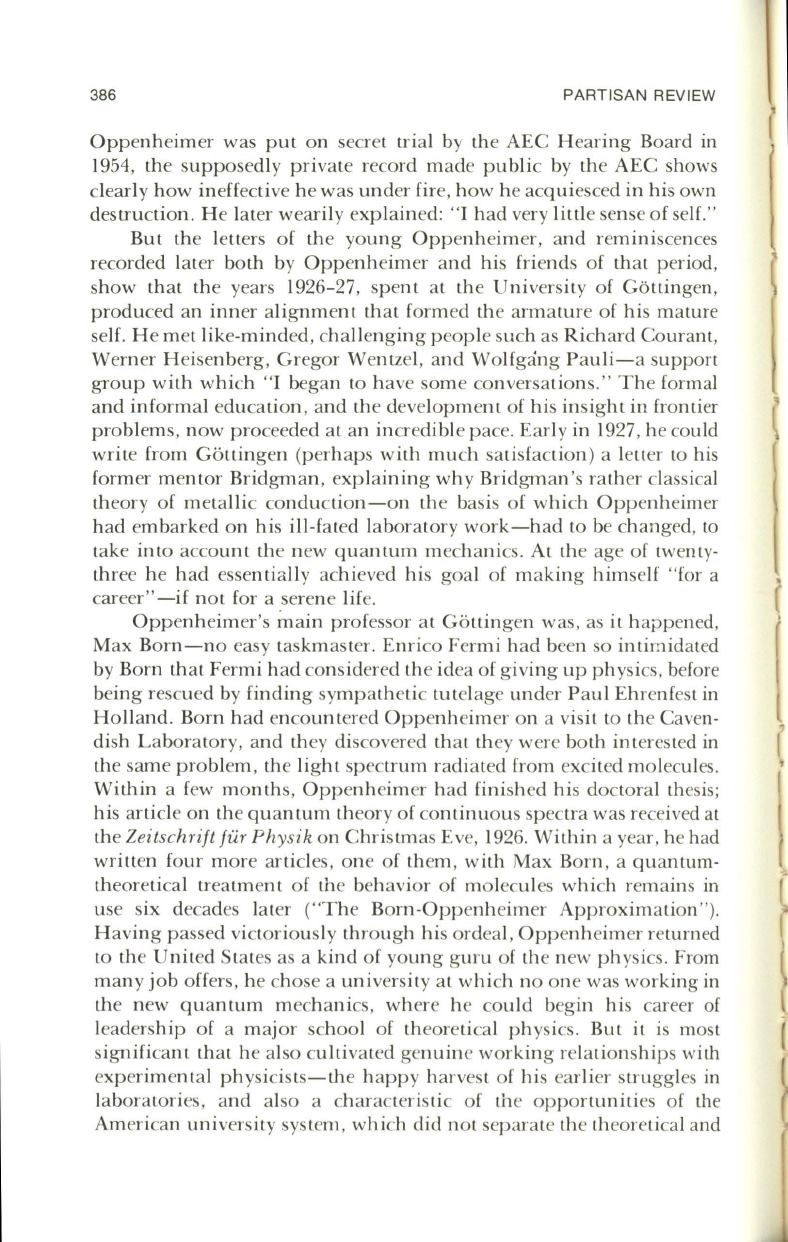
386
PARTISAN REVIEW
Oppenheimer was put on secret trial by the AEC Hearing Board in
1954,
the supposedly private record made public by the AEC shows
clearly how ineffective he was under fire, how he acquiesced in his own
destruction. He later wearily explained: "I had very little sense of self."
But the letters of the young Oppenheimer, and reminiscences
recorded later both by Oppenheimer and his friends of that period,
show that the years
1926-27,
spent at the University of Gottingen,
produced an inner alignment that formed the armature of his mature
self. He met like-minded, chall enging people such as Richard Courant,
Werner Heisenberg, Gregor Wentzel, and Wolfgang Pauli-a support
group with which "I began to have some conversations." The formal
and informal education, and the development of his insight in frontier
problems, now proceeded at an incredible pace. Early in
1927,
he could
write from Gottingen (perhaps with much satisfaction) a letter to his
former mentor Bridgman, explaining why Bridgman's rather classical
theory of metallic conduction-on the basis of which Oppenheimer
had embarked on his ill-fated laboratory work-had to be changed, to
take into account the new quantum mechanics. At the age of twenty–
three he had essentiall y achieved his goa l of making himself "for a
career" -if not for a serene life.
Oppenheimer's main professor at Gottingen was, as it happened,
Max Born-no easy taskmaster. Enrico Fermi had been so intimidated
by Born that Fermi had considered the idea of giving up physics, before
being rescued by finding sympathetic tutelage under Paul Ehrenfest in
Holland. Born had encountered Oppenheimer on a visit to the Caven–
dish Laboratory, and they discovered that they were both interested in
the same problem, the light spectrum radiated from excited molecules.
Within a few months, Oppenheimer had finished his doctoral thesis;
his article on the quantum theory of continuous spectra was received at
the
Zeitschrift fur Physik
on Christmas Eve,
1926.
Within a year, he had
written four more articles, one of them, with Max Born, a quantum–
theoretical treatment of the behavior of molecules which remains in
use six decades later ("The Born-Oppenheimer Approximation").
Having passed victoriously through his ordeal, Oppenheimer returned
to the United States as a kind of young guru of the new physics. From
many job offers, he chose a university at which no one was working in
the new quantum mechanics, where he cou ld begin his career of
leadership of a major school of theoretical physics. But it is most
significant that he also cultivated genuine working relationships with
experimental physicists-the happy harvest of his earlier struggles in
laboratories, and also a characteristic of the opportun ities of the
American university system, which did not separate the theoretical and
\
I
,
(
I


